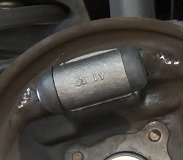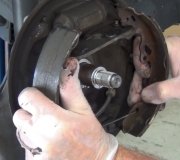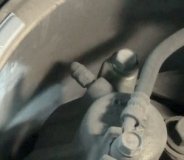Those spurts prove the master cylinder is working. When the pistons in it just start to move, the fluid being pushed finds it is easiest to flow up through the fluid return ports into the reservoir. Those are the spurts you see. Once the pistons move about 1/4", the rubber lip seals move past those ports, then the fluid ahead of them is trapped, and has no choice but to become pressurized as the brake pedal is moved further and further. The fluid has to go to the wheels. If it finds that easy to do, the brake pedal will go to the floor with little or no pressure being felt.
I know that sounds simplified, but it might lend itself to looking at the problem in a different light.
You might consider using a vacuum-operated bleeder at the wheels. The most common are a hand-operated pump with a collection cup. There is also a compressed air-driven pump that is typically used for evacuating AC systems. Either of those will cause any air in the system to expand and be easier to pull out.
One clue to look at is the fluid coming out will be clear if it has made it from the master cylinder. If it is dark, which is normal from being hot, the new stuff has not made it to the wheels yet, along with any air in it.
Also, be aware that when you do vacuum-bleeding, air is going to sneak through the threads of the bleeder screw and show up in the fluid. Those bubbles will be very small, and many of them in a steady stream. You can ignore them. Air coming out of the system will be very few large bubbles.
Another alternative is pressure-bleeding with a "bleeder ball". Those have gone by the wayside because today there are just too many variations of reservoir adapters. They can be messy too. Most of us get satisfactory results from gravity-bleeding.
When people resort to pedal-bleeding with a helper, it is easy to develop hundreds of pounds of fluid pressure. At that pressure, air will contract and it will dissolve into the fluid, only to show up later as a mushy pedal. Bleeder balls hold about four gallons of clean brake fluid, and compressed air, separated by a rubber bladder. A built-in regulator limits that air pressure to fifteen pounds. That is plenty to force the fluid through the system at a pretty good clip, but not enough to dissolve the air into it.
You might have to visit an Automotive program at a nearby community college to find a bleeder ball. We had one for training purposes, only because it could still be possible to find some at repair shops, and the students needed to know what to do with them.
I feel compelled to add another unrelated chapter to this sad story. When I was a student, a few years ago, we had an engine with an internal oil leak that caused a total loss of oil pressure. The only way we were able to find it was to pressurize the system with the engine taken apart, and we did that with the bleeder ball. (The cause of the leak became painfully apparent long before the four gallons of oil was used up. The horrendously-important detail though, was once we were done with the procedure, the instructor destroyed the bleeder ball.
The entire brake hydraulic system can be contaminated with a single drop of petroleum product, like engine oil, power steering fluid, transmission fluid, axle grease, or penetrating oil. The instructor didn't want to risk anyone using the bleeder ball for brake fluid in the future.
Later, when working at a mass merchandiser's Auto Shop in the 1980's, we learned about a problem they had in another state where an inexperienced mechanic used a clean rag to wipe out a funnel used for engine oil, then he used it to fill the brake bleeder ball. The minor residue in the funnel introduced enough contamination to destroy the hydraulic systems in over a dozen cars. The only proper repair is to remove every part that contains a rubber part that contacts the fluid, flush and dry the steel lines, then install all new parts. That gets to be real expensive. It's the combination valve, with its rubber o-rings, that gets overlooked. The contamination will leach out of that and recontaminate the new fluid and parts.
The reason I included this chapter was to point out one reason it is so hard to find bleeder balls today. I would not want to trust my cars to the previous person who used the tool, and possibly contaminated it.
Saturday, December 31st, 2016 AT 1:52 PM




